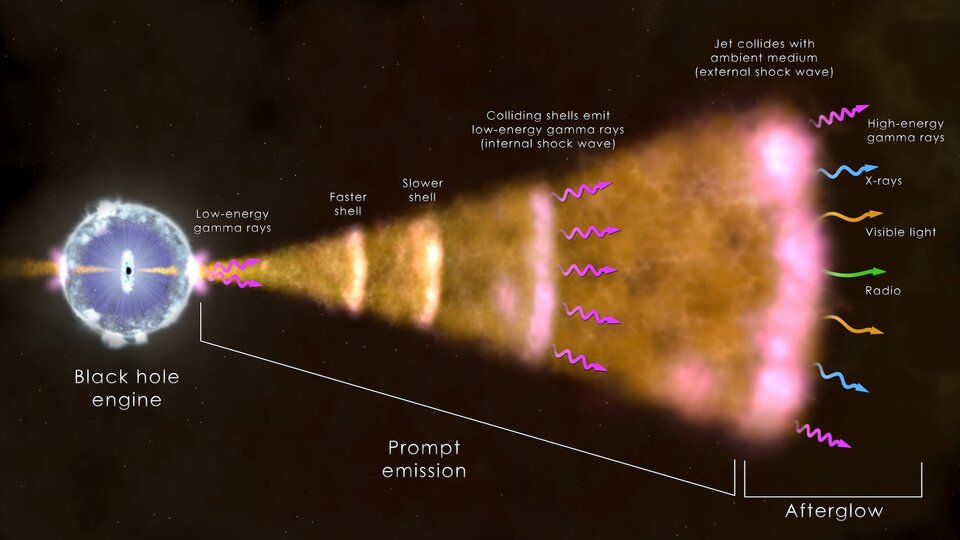17.06.2024

Europe’s newest rocket soon launches, taking with it many space missions, each with a unique objective, destination and team at home, cheering them on. Whether launching new satellites to look back and study Earth, peer out to deep space or test important new technologies in orbit, Ariane 6’s first flight will showcase the versatility and flexibility of this impressive, heavy-lift launcher. Read on for all about GRBBeta, then see who else is flying first.
GRBBeta is a successor to the world’s smallest astrophysics space observatory, GRBAlpha – the first CubeSat to detect a gamma-ray burst (GRB) from space; still working well after three years in orbit and over 135 ‘transients’ detected to date.

Building on Alpha’s success, GRBBeta will serve as a ‘testbed’ for a range of new technologies that will be vital for future constellations of GRB-detecting satellites and other CubeSat missions.
Gamma-ray bursts are immensely energetic explosions that have been observed in distant galaxies. They are the brightest and most extreme explosive events in the Universe – a typical GRB will release as much energy in a few seconds as the Sun will in its entire 10-billion-year lifetime.

GRBs are thought to be released during a hypernova – when a particularly massive star powerfully implodes to form a neutron star or black hole. After an enormous initial flash of gamma rays, an ‘afterglow’ emits longer wavelengths in X-ray, ultraviolet, optical, infrared, microwave and radio.
The satellite’s prime contractor is the Faculty of Aeronautics at the Technical University of Košice, while Spacemanic, a turnkey nanosatellite mission provider and CubeSat component manufacturer based in Czechia, has spearheaded the construction of the cutting-edge two-unit (2U) GRBBeta CubeSat. Its scientific payloads have been built in a Hungarian, Czech, Japanese and Canadian collaboration and represent a significant leap forward in space technology.

The Hungarian Konkoly Observatory led the development of GRBBeta’s gamma-ray burst detector, while the Czech Masaryk University led the science data analysis. The Japanese Hiroshima University significantly contributed to the detector hardware, and the Canadian University of Toronto built an experimental mini-UV Space Telescope.
Just as with the GRBAlpha mission, Spacemanic has been responsible for the overall construction of GRBBeta – from project management to mission design to building and integrating almost all of its components and developing the ground segment.

“GRBBeta is a collaborative project that involves diverse technological innovations from multiple collaborators,” explains Jakub Kapuš, CEO of Spacemanic. “To put it in simple words, we were looking to find out how much science we could ‘cram’ into two units of space. As it turns out, the answer is “a lot”.
Aside from the gamma-ray burst experiment, GRBBeta also features amateur radio capabilities and several other experiments.
“One of the technologies to be tested we are particularly thrilled about is the first large ultraviolet CMOS (Complementary Metal Oxide Semiconductor) image sensor from the Dunlap Institute at the University of Toronto,” continues Jakub Kapuš.
Semiconductor image sensors convert light into electrical signals and generally have higher resolution and lower power consumption than traditional CCD (charge-coupled device) sensors, i.e. cameras.

Ultimately, GRBBeta’s purpose is to serve as an affordable astronomy-grade space camera at better or equal performance to cost-prohibitive alternatives.
“GRBAlpha has shown that small CubeSats are capable of doing in-orbit science with a fraction of the cost and time required to launch a standard full-sized satellite mission,” explains Daniela Jovic, CCO at Spacemanic.
“In this way, it is opening up the market to a wide range of nations, universities and research institutions that would otherwise be unable to get their experiments up to space. Along the way, we have high hopes that the success of GRBBeta and the other smallsat missions we are preparing will serve as an inspiration for the next big project in a small cube.”

Along with its astrophysics instruments, GRBBeta is also equipped with a Murgas ‘transceiver’ – a device that can both transmit and receive data – presenting a unique opportunity for the global amateur radio community.
The satellite will be visible to the open-source SatNOGS network, so anyone with an internet connection will be able to view its live telemetry (data) via the Grafana Dashboard from the comfort of their home and track and check the health status of the small space marvel.
"It's truly an honor to be part of this landmark moment in European space exploration. Our team has poured their hearts and souls into reaching this stage," explains Natália Gogolová, mechanical engineer at Spacemanic.
“When GRBBeta left our office for the launchpad, it was a sentimental reminder of all the dedication and teamwork that brought us to this point. The anticipation of receiving the first signals back from GRBBeta is absolutely thrilling – we're all eagerly looking forward to that moment.”
Quelle: ESA
